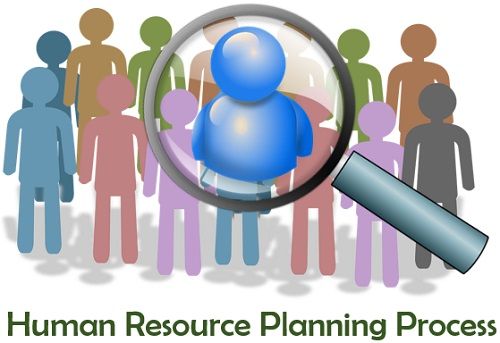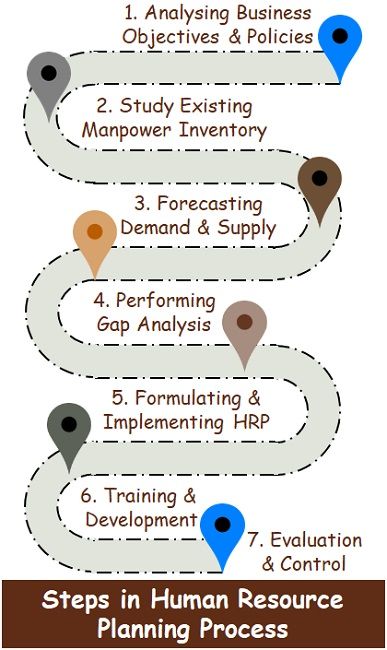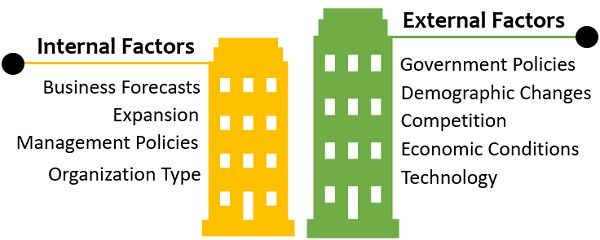Definition: The Human Resource Planning Process critically analyses, forecasts, and allocates human resources as per business goals. It assists organizations in estimating their existing as well as future manpower requirements.
This process is carried out in all organizations, big or small. We can also refer to it as Manpower Requirement Process.
It serves as a bridge between the firm’s Human Resource Management (HRM) and its strategic plan.

The process is time-consuming. As it covers the addition/elimination of the job positions. Thus, managers need to conduct an in-depth analysis to estimate manpower requirements.
We can compile the complete process into seven steps. The initial five steps in the Human Resource Planning Process include:
- Identification
- Analysis
- Implementation of the action plan
However, the last two steps consist of ‘Training‘ and ‘Control’ of the appointed staff.
Content: Human Resource Planning Process
- What is Human Resource Planning?
- Steps in the Human Resource Planning Process
- Advantages
- Factors Affecting HRP process
- Example
- Conclusion
What is Human Resource Planning?
Human Resource Planning (HRP) determines the requirement of personnel as per organizational objectives. The ultimate aim of HRP is the optimum allocation of a qualified workforce.
In HRP, the manager recruits human resources for present and future requirements. It involves recruiting the correct number of people to meet organizational goals.
Steps in the Human Resource Planning Process
The steps involved in the HRP process are as follows:
- Analyzing Business Objectives and Policies
- Study Existing Manpower Inventory
- Forecasting Demand and Supply
- Performing Gap Analysis
- Formulating and Implementing HRP
- Training and Development
- Evaluation and Control

Analyzing Business Objectives and Policies
The initial step in the HRP process is the analysis of business objectives.
The HR manager will conduct a detailed analysis of the business’s vision and mission. Subsequently, design the HRP objectives and policies in the direction of the firm’s goals.
In this step, the managers create policies on the following HR processes:
- Sources of recruitment, i.e. internal or external recruitment.
- The selection procedure, training & development program, etc.
- Review and restructure the existing job roles strategically.
- Adoption of downsizing or rightsizing to remain competitive.
- Automation of processes and their impacts.
Study Existing Manpower Inventory
It is the second step after mapping out HRP objectives and policies.
The managers need to study their existing workforce skills and capabilities. We must find out whether the present staff can fulfill the future demand.
We must consider the following factors at the time of the manpower inventory study:
- Skills and capabilities of the employees.
- Analysis of the demographic characteristics of the employees.
- Productivity, Creativity and Absenteeism in the previous year.
- Eligibility for the current and future job profile, etc.
Forecasting Demand and Supply
1. Demand Forecasting
With the ever-changing environment, the HR demand varies from time to time. We must anticipate the future HR requirements to achieve multiple goals.
The managers find out the number of people with adequate skills to develop a staff mix.
In this stage, we can make projections regarding:
- Addition of new job roles.
- Creation of Vacancies.
- Prevent a shortage of people.
- Number and kind of personnel required for production and management.
- Right quantity of personnel to meet business long-term goals, etc.
Techniques for Demand Forecasting:
- Managerial Judgement
- Ratio/Trend Analysis
- Regression Analysis
- Work-study Techniques
- Delphi Technique
- Flow Model
2. Supply Forecasting
After demand forecasting, we must assess the firm’s capabilities to supply the required workforce. Managers may procure personnel from within and outside the firm.
Sources of human resources supply:
- Existing Workforce
- Internal Supply
- External Supply
We must analyze the sufficiency of the existing workforce first. After that, go for the internal and external sources of supply.
Supply forecasting helps in estimating:
- Staff mixes for the future.
- It helps to prevent excess or shortage of manpower.
- The number of personnel required to fill the planned positions.
Techniques for Supply Forecasting:
- Staffing Tables
- Markov Analysis
- Skills Inventory
- Replacement Chart
Performing Gap Analysis
Here, the net human resource requirement is to be estimated. For this, we need to reconcile the forecasted demand and supply.
Variance calculation between future demand and supply is known as Gap Analysis. Both qualitative and quantitative gap is investigated.
The result of this analysis is either Surplus or Deficit of human resource requirements.
- Deficit: It depicts the number of personnel to be recruited.
- Surplus: It suggests the number of personnel to be terminated.
Formulating and Implementing HRP
An action plan is formulated and implemented based on the gap analysis. The HR manager may take the following actions:
In the case of Surplus:
- Hold hiring
- Reduce working Hours
- Offer voluntary retirement, etc
In case of Deficit:
- Recruit new employees
- Retain employees
- Transfers & Promotions
- Train existing employees, etc
Training and Development
It is the next step after the successful implementation of the action plan.
Training & development programs are organized for fresh recruits. These programs help employees develop the required skills to perform their job efficiently.
Training is of two types:
- General Training
- Specific Training
Evaluation and Control
It is the last and final step in the human resource planning process. One must test whether the implementation of the action plan meets the HRP objectives.
Timely review and control help in error detection and taking corrective measures.
Advantages
HRP process is advantageous to firm in following ways:
- It is an essential constraint Succession Planning procedure.
- Find out the Surplus or Deficit in the manpower inventory of the business.
- Helps in reducing unnecessary job positions from the organizational structure.
- The HRP process helps cut costs, which also results in improved efficiency.
- It enables HR managers to make optimum use of firms’ resources.
Factors Affecting the Human Resource Planning Process

Internal Factors
- Forecasts Regarding Business
The business forecasts will affect the HRP process. For instance, layoffs as a result of decreased profitability. - Expansion
It analyzes and identifies the exact demand for human resources within the business. - Management Policies
Management policies lay a significant impact on the HRP process. It consists of training employees for operating new machinery, skill development programs, etc. - Type of the Organization
The requirement of the workforce varies in different forms of organizations. A big firm needs huge manpower, whereas a small-sized firm needs less workforce.
External Factors
- Government Policies
Any change in labor law directly affects the HRP process. It may include changes in minimum wage rate, etc. - Demographic Changes
Demographics include factors like education & culture. The HR managers have to plan policies according to the changes in these factors. - Competition
To remain competitive, managers need to recruit a qualified workforce. The right personnel at the right place, working with maximum productivity. - Economic Conditions
The economic slowdown in the county leads to layoffs in many organizations. - Technology
The technical changes and automation result in a decreased demand for the workforce.
Example of Human Resource Planning Process
Lets us understand the Human Resource Planning process by taking the example of Mojo Ltd.
Mojo Ltd. is a toy manufacturer and plans to open another corporate office in the city.
The HR manager of Mojo Ltd. has to plan net manpower requirements for the upcoming financial year.
We will see how the manager uses the HRP process model for efficient staffing.
- Step:1 Analyzing Business Objectives and Policies
Based on the company’s announcement, the manager set the HRP objective to staff for the new office. - Step:2 Study Existing Manpower Inventory
The manager will review the performances of all the current employees in the company.
He analyzed:- We can promote some employees to the managerial level.
- And one Telecaller is capable of becoming an excellent team lead.
- Step:3 Forecasting Demand and Supply
In the new office, they need ten personnel in different job roles.
He can mobilize 5 senior officials of the managerial level from the other branches. - Step:4 Performing Gap Analysis
The manager reconciled the demand with supply. Consequently, investigated the requirement of five personnel for the new office. - Step:5 Formulating and Implementing HRP
He planned the recruitment process for five vacancies.
The manager used mediums like Newspapers and Job Portals for the procedure. Also, he preferred candidates from nearby areas to retain employees in the long run.
He selected five appropriate candidates for the vacancies. - Step:6 Training and Development
The manager organized a 2 weeks training & development program for all ten candidates.
The program’s central idea is to develop skills like:- Verbal Communication
- Buyer Research.
- Step:7 Evaluation and Control
HR manager critically evaluated each employee’s performance every three months. Also, he guided and resolved employee issues for smooth working.
Final Words
The human resources planning process model is used to estimate future HR requirements. It is a systematic approach by which managers can meet their HRP objectives.
Through the HRP process, organizations can efficiently allocate their human resources.
Satish Singla says
Brief and concise. Well structured .